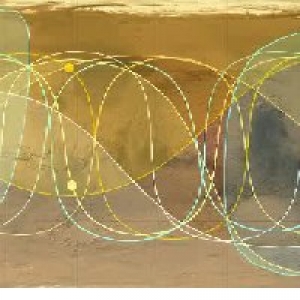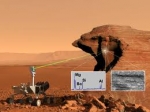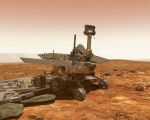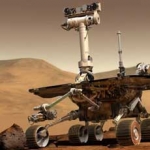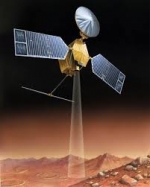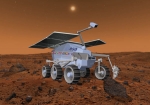Displaying items by tag: Mars
Mars GNSS FATIMA
The planetary science of recent days is very focused on our neighbor, planet Mars. Current navigation and positioning systems used by surface rovers or orbital systems are often complicated and their possible maintenance requires a huge effort of the ground control teams on Earth. Construction and design of these probes is expensive, due to necessary redundancy of their on-board systems, usually consisting of computers, sensors, navigation cameras and other intelligent technologies. Complexity of these current systems is making them very sensitive. Any small error in position calculation can result not only in wrong direction or in bad position determination, but can even endanger the whole mission. For example when such vehicle reaches some danger zone – like the edge of a crater, valley, or rocky area. Precise navigation and timing is one of the key factors of the next steps of Mars research. We are heading towards the next giant leap of Mankind, when the first humans will possibly land on a surface of Mars. Advanced robotic missions including flying robots, surface rovers, new orbital probes and possible future human mission, will need the one universal positioning system and one the universal time service. This can be resolved by proposed global navigation satellite system for Mars. We have used the name FATIMA as acronym for such system, which simply means Fix And TIme provisioning system for MArs. The constellation of FATIMA satellites orbiting Mars will provide real time positioning service, navigation service and timing service, for multiple users. This system will not be analogy to our Earth based GPS, Galileo or Glonass systems, but will be more complex and possibly maintained by the international control body on Earth. The system will be suitable also for the geodetic measurements and for the possible tectonic research of Mars. It will allow us to come personally beyond our own current human world. Author of the concept of the Mars GNSS FATIMA and of the research related to this is Dr. Jozef Kozar (http://www.sciencemars.com/kozar).
2001 Mars Odissey (Mars orbiter)
2001 Mars Odyssey is a robotic spacecraft orbiting the planet Mars. The project was developed by NASA, and contracted out to Lockheed Martin.
Its mission is to use spectrometers and electronic imagers to detect evidence of past or present water and volcanic activity on Mars. It is hoped that the data Odyssey obtains will help answer the question of whether life has ever existed on Mars. It also acts as a relay for communications between the Mars Exploration Rovers, Mars Science Laboratory, and the Phoenix lander to Earth. The mission was named as a tribute to Arthur C. Clarke, evoking the name of 2001: A Space Odyssey.
Odyssey was launched April 7, 2001 on a Delta II rocket from Cape Canaveral Air Force Station, and reached Mars orbit on October 24, 2001, at 2:30 a.m. UTC (October 23, 7:30 p.m. PDT, 10:30 p.m. EDT). The spacecraft's main engine fired in order to brake the spacecraft's speed, which allowed it to be captured into orbit around Mars. Odyssey used a technique called "aerobraking" that gradually brought the spacecraft closer to Mars with each orbit. By using the atmosphere of Mars to slow down the spacecraft in its orbit, rather than firing its engine or thrusters, Odyssey was able to save more than 200 kilograms (440 lb) of propellant. Aerobraking ended in January, and Odyssey began its science mapping mission on February 19, 2002. It is currently in a polar orbit around Mars with an altitude of about 3,800 km or 2,400 miles.
By December 15, 2010 it broke the record for longest serving spacecraft at Mars, with 3,340 days of operation, claiming the title from NASA's Mars Global Surveyor.
Chemistry and Camera complex instrument (ChemCam)
Chemistry and Camera complex (ChemCam) is a suite of remote sensing instruments on Mars for the Curiosity rover.
As the name implies, ChemCam is actually two different instruments combined as one: a laser-induced breakdown spectroscopy (LIBS) and a Remote Micro Imager (RMI) telescope. The purpose of the LIBS instrument is to provide elemental compositions of rock and soil, while the RMI will give ChemCam scientists high-resolution images of the sampling areas of the rocks and soil that LIBS targets. The LIBS instrument can target a rock or soil sample from up to 7 m (23 ft) away, vaporizing a small amount of it with about 50 to 75 5-nanosecond pulses from a 1067 nm infrared laser and then observing the spectrum of the light emitted by the vaporized rock.
ChemCam has the ability to record up to 6,144 different wavelengths of ultraviolet, visible, and infrared light. Detection of the ball of luminous plasma will be done in the visible, near-UV and near-infrared ranges, between 240 nm and 800 nm. The first initial laser testing of the ChemCam by Curiosity on Mars was performed on a rock, N165 ("Coronation" rock), near Bradbury Landing on August 19, 2012.
The ChemCam team expects to take approximately one dozen compositional measurements of rocks per day.
Spirit rover (MER-A)
Spirit, MER-A (Mars Exploration Rover – A), is a robotic rover on Mars, active from 2004 to 2010.
It was one of two rovers of NASA's ongoing Mars Exploration Rover Mission. It landed successfully on Mars at 04:35 Ground UTC on January 4, 2004, three weeks before its twin, Opportunity (MER-B), landed on the other side of the planet. Its name was chosen through a NASA-sponsored student essay competition. The rover became stuck in late 2009, and its last communication with Earth was sent on March 22, 2010.
The rover completed its planned 90-sol mission. Aided by cleaning events that resulted in higher power from its solar panels, Spirit went on to function effectively over twenty times longer than NASA planners expected. Spirit also logged 7.73 km (4.8 mi) of driving instead of the planned 600 m (0.4 mi), allowing more extensive geological analysis of Martian rocks and planetary surface features. Initial scientific results from the first phase of the mission (the 90-sol prime mission) were published in a special issue of the journal Science.
Opportunity rover (MER-B)
Opportunity, MER-B (Mars Exploration Rover – B), is a robotic rover active on the planet Mars since 2004.
Launched on July 7, 2003, Opportunity landed on Mars' Meridiani Planum on January 25, 2004, three weeks after its twin Spirit (MER-A), also part of NASA's Mars Exploration Rover Mission, touched down on the other side of the planet. While Spirit became immobile in 2009 and ceased communications in 2010, Opportunity remains active as of 2013, having already exceeded its planned 90 sol (Martian days) duration of activity by 9 years, 215 days (in Earth time). Opportunity has continued to move, gather scientific observations, and report back to Earth for over 38 times its designed lifespan.
Mission highlights include the initial 90 sol mission, finding extramartian meteorites such as Meridiani Planum, and over two years studying Victoria crater. It survived dust-storms and reached Endeavour crater in 2011, which has been described as a "second landing site".
The Jet Propulsion Laboratory (JPL), a division of the California Institute of Technology in Pasadena, California, manages the Mars Exploration Rover project for NASA's Science Mission Directorate in Washington, D.C..
Insight Lander
InSight is a Mars lander mission planned by NASA for launch in 2016. The name stands for Interior Exploration using Seismic Investigations, Geodesy and Heat Transport.
The mission's objective is to place a stationary lander equipped with a seismometer and heat flow probe on the surface of Mars to study its early geological evolution. This would bring new understanding of the Solar System's terrestrial planets — Mercury, Venus, Earth, Mars — and Earth's Moon. By reusing technology from the Mars Phoenix lander, which successfully landed on Mars in 2008, it is expected that the cost and risk will be reduced.
InSight was initially known as GEMS (Geophysical Monitoring Station), but changed its name in early 2012 at the request of NASA.
Mars Reconnaissance Orbiter
Mars Reconnaissance Orbiter (MRO) is a multipurpose spacecraft designed to conduct reconnaissance and Exploration of Mars from orbit.
The spacecraft was built under the supervision of the Jet Propulsion Laboratory (JPL). The mission is managed by the JPL, at California Institute of Technology, La Canada Flintridge, California, for the NASA Science Mission Directorate. It was launched August 12, 2005, and attained Martian orbit on March 10, 2006.
In November 2006, after five months of aerobraking, it entered its final science orbit and began its primary science phase. As MRO entered orbit it joined five other active spacecraft which were either in orbit or on the planet surface: Mars Global Surveyor, Mars Express, Mars Odyssey, and two Mars Exploration Rovers; at the time a record for the most operational spacecraft in the immediate vicinity of Mars.
MRO contains a host of scientific instruments such as cameras, spectrometers, and radar, which are used to analyze the landforms, stratigraphy, minerals, and ice of Mars. It paves the way for future spacecraft by monitoring Mars' daily weather and surface conditions, studying potential landing sites, and hosting a new telecommunications system. MRO's telecommunications system will transfer more data back to Earth than all previous interplanetary missions combined, and MRO will serve as a highly capable relay satellite for future missions.
Explore Mars Inc.
Explore Mars Inc. is a project-oriented, international non-profit organization passionately dedicated to awareness and action resulting in successful human exploration of Mars.
Explore Mars was created to promote science and technology innovation and education with a use for Mars Exploration. Through a series of technology innovation awards, scientific symposiums and workshops, Mars analog work, technology demonstrations, and other programs, we provide a platform for scientists and "citizen scientists" to engage in meaningful space exploration research and development in the private sector.
The new focus on private sector investment in space creates a unique opportunity for 'Explore Mars'. "Not only do we plan to promote the humans to Mars cause," said Explore Mars Executive Director, Chris Carberry, "but with the right mix of prizes, programming, and projects, we can make a significant contribution in advancing the cause of sending humans to Mars."
Explore Mars Inc. was formed in 2010.
Mars Institute
The Mars Institute is a non-profit research organization whose mission is to further the scientific study, exploration and public understanding of Mars. It is an international non-governmental organization.
It is conducting high-quality, peer-reviewed research, and educating the public on the progress toward and benefits of Mars exploration.
It was incorporated as a non-profit corporation in both California, USA, and Canada in 2002.
ExoMars
ExoMars (Exobiology on Mars) is a planned Mars mission to search for possible biosignatures of Martian life, past or present. This astrobiological mission is currently (September 2012) under development by the European Space Agency (ESA) with likely collaboration by the Russian Federal Space Agency (Roscosmos).
The program includes several spacecraft elements to be sent to Mars on two launches. An orbiter and a stationary lander is planned for 2016, and a Russian lander to deliver the rover is planned for 2018.

